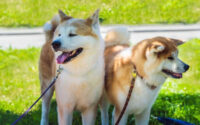Arabian dogs
Amidst the vast and venerable sands of the Arabian Peninsula, a distinctive group of canine breeds has thrived alongside human civilization for thousands of years. These dogs have not only adapted to the harsh desert environment but have become an integral part of Arabian heritage. This article delves into the legacy of Arabian dogs, exploring their history, breeds, adaptations, conservation efforts, and their role in Arabian culture, as well as examining the challenges they face today.
Unveiling the Heritage of Arabian Dogs
Table of Contents

The history of Arabian dogs is deeply entwined with the nomadic and sedentary cultures of the Middle East. For centuries, these dogs have been companions, hunters, and guardians for the Bedouins and other inhabitants of the region. Archaeological evidence, such as inscriptions and carvings, suggests their presence alongside humans for millennia. These canines are not just pets but are revered for their loyalty, strength, and ability to endure the arid climate. Oral traditions and folklore celebrate the deeds of these dogs, underscoring their importance in local heritage. Moreover, they are often mentioned in ancient texts, which further demonstrates their significance throughout Arabian history.
Exploring Breeds: Saluki to Sloughi

Two of the most prominent breeds that hail from the Arabian Peninsula are the Saluki and the Sloughi. Often referred to as the “Royal Dog of Egypt,” the Saluki is believed to be one of the oldest domesticated dog breeds in the world. These graceful hounds are known for their incredible speed and agility, which made them ideal for hunting in vast deserts. In contrast, the Sloughi, also known as the Arabian Greyhound, shares similar attributes but is typically more robust and muscular. Both breeds exhibit a natural elegance and dignity, with deep connections to the traditions and history of the region.
Comparison Table: Saluki vs. Sloughi
| Feature | Saluki | Sloughi |
|---|---|---|
| Origin | Fertile Crescent | North Africa (Maghreb) |
| Build | Slender and graceful | More muscular and robust |
| Coat | Smooth and silky | Short and dense |
| Temperament | Independent and reserved | Loyal and affectionate |
| Hunting Skill | Exceptional sight-hunter | Powerful and enduring |
| Cultural Significance | Royal and noble companion | Symbol of wealth and status |
Arabian Canines: Adaptations to Desert Life

Arabian dogs have evolved to survive in one of the most unforgiving climates on Earth. Their physical and behavioral adaptations are a testament to their resilience:
- Coat and Color: They often have short and light-colored coats that reflect sunlight and help them to avoid overheating.
- Physiology: Long legs and a lean body shape allow for efficient dissipation of heat and enable the dogs to move swiftly over sandy terrains.
- Behavior: Many Arabian breeds are known to conserve energy during the heat of the day and become more active during cooler temperatures, displaying a crepuscular lifestyle.
- Hunting Skills: Their heightened senses, particularly sight and hearing, make them superb hunters even in the vast openness of the desert.
- Endurance: These dogs are capable of covering long distances without water, which is essential in arid regions.
- Social Structure: They have developed strong social bonds with their human companions, which has been crucial for their mutual survival in harsh conditions.
Preserving Bloodlines: Conservation Efforts

Recognizing the importance of Arabian dogs, there are several initiatives aimed at preserving their bloodlines. Conservationists and breed enthusiasts have been working tirelessly to maintain the purity and traditional characteristics of these breeds. Breeding programs are carefully managed to avoid genetic bottlenecks and to sustain the health of the populations. Additionally, there are registries and clubs dedicated to these dogs, which keep detailed records of lineage and promote responsible ownership. International collaboration also plays a role, with genetic studies and exchanges between countries helping to diversify gene pools. Preservation efforts are not just about maintaining pedigree but also about protecting a living piece of history.
The Role of Dogs in Arabian Culture
Dogs have held various roles in Arabian culture throughout the ages. They have been:
- Protectors: Guarding nomadic tribes and their livestock against predators and thieves.
- Hunters: Assisting in tracking and capturing game in the vast deserts, which is a testament to their skill and partnership with humans.
- Symbols: Representing various traits such as loyalty, purity, and nobility in local folklore and art.
- Helpers: Serving as companions and helpers, aiding in tasks ranging from herding to providing comfort and companionship.
- Cultural Icons: Featuring in literature and poetry, highlighting the admiration and respect they command.
- Spiritual Beings: In some traditions, dogs are regarded with spiritual significance, believed to possess protective qualities and to ward off evil spirits.
Arabian Dogs Today: Status and Challenges

Today, Arabian dogs face a multitude of challenges. Urbanization and changing lifestyles have reduced the need for traditional canine roles, leading to a decline in their numbers. The influx of foreign dog breeds and interbreeding poses a threat to the purity of Arabian breeds. Additionally, there is a need for greater awareness and education about the value of these native dogs and their conservation. Animal welfare organizations are striving to address issues such as habitat loss, neglect, and abandonment. Despite these challenges, there is a renewed interest in Arabian breeds, with a growing appreciation for their unique qualities and historical significance. The future of these noble desert canines will depend on concerted efforts to protect and celebrate their legacy.
The Arabian dogs, with their noble stature and enduring spirit, remain a testament to the rich cultural tapestry of the Middle East. As living symbols of heritage, their preservation is critical not only for maintaining biological diversity but also for honoring the cultural history they embody. Understanding their past, recognizing their adaptations to the desert, and ensuring their future through conservation efforts are responsibilities that we share. As they navigate the modern world’s challenges, it is our collective hope that the Arabian dogs continue to thrive and be celebrated for generations to come.



